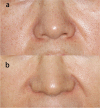An update on fractional picosecond laser treatment: histology and clinical applications
- PMID: 36658259
- PMCID: PMC9852188
- DOI: 10.1007/s10103-022-03704-y
An update on fractional picosecond laser treatment: histology and clinical applications
Abstract
Picosecond lasers have a very short pulse duration and a high peak power density. When fractional optical delivery systems are attached to picosecond lasers, they generate an array of concentrated microspots with a high fluence surrounded by areas with a low fluence. This article discusses the histologic characteristics and clinical applications of fractional picosecond laser treatment. Fractional picosecond laser produces laser-induced optical breakdown (LIOB) and laser-induced cavitation (LIC) in the epidermis and dermis respectively, and can encourage skin regeneration and dermal remodeling. It has been shown that fractional picosecond laser has a positive effect on facial photoaging, enlarged facial pores, dyspigmentation, wrinkles, and atrophic scars. Further research is still needed to confirm the benefits of fractional picosecond lasers.
Keywords: Clinical applications; Fractional optical delivery systems; Histologic characteristics; Picosecond laser.
© 2023. The Author(s).
Conflict of interest statement
MRH declares the following potential conflicts of interest. Scientific Advisory Boards: Transdermal Cap Inc, Cleveland, OH; Hologenix Inc. Santa Monica, CA; Vielight, Toronto, Canada; JOOVV Inc, Minneapolis-St. Paul MN; Sunlighten, Kansas City, MO; Consulting; USHIO Corp, Japan; Sanofi-Aventis Deutschland GmbH, Frankfurt am Main, Germany; Klox Asia, Guangzhou, China. Stockholding: Niraxx Light Therapeutics, Inc., Irvine CA; JelikaLite Corp, New York NY. All other authors declare no competing interests.
Figures


Similar articles
-
Histology of ex vivo skin after treatment with fractionated picosecond Nd:YAG laser in high and low-energy settings.J Cosmet Laser Ther. 2020;22(1):43-47. doi: 10.1080/14764172.2019.1710536. Epub 2020 Jan 3. J Cosmet Laser Ther. 2020. PMID: 31900067
-
Optical Effects of Focused Fractional Nanosecond 1064-nm Nd:YAG Laser: Techniques of Application on Human Skin.Lasers Surg Med. 2024 Aug;56(6):557-563. doi: 10.1002/lsm.23812. Epub 2024 Jun 18. Lasers Surg Med. 2024. PMID: 38890780
-
Microlesion healing dynamics in in vivo porcine skin after treatment with 1064 nm picosecond-domain Nd:YAG laser.J Biophotonics. 2023 Apr;16(4):e202200349. doi: 10.1002/jbio.202200349. Epub 2023 Jan 13. J Biophotonics. 2023. PMID: 36606608
-
Review of Lasers and Energy-Based Devices for Skin Rejuvenation and Scar Treatment With Histologic Correlations.Dermatol Surg. 2022 Apr 1;48(4):441-448. doi: 10.1097/DSS.0000000000003397. Dermatol Surg. 2022. PMID: 35165220 Review.
-
Delivery of light to the skin through ablated conduits.Lasers Surg Med. 2017 Jan;49(1):69-77. doi: 10.1002/lsm.22533. Epub 2016 May 19. Lasers Surg Med. 2017. PMID: 27197620 Review.
Cited by
-
Advancements in Laser Therapies for Dermal Hyperpigmentation in Skin of Color: A Comprehensive Literature Review and Experience of Sequential Laser Treatments in a Cohort of 122 Indian Patients.J Clin Med. 2024 Apr 5;13(7):2116. doi: 10.3390/jcm13072116. J Clin Med. 2024. PMID: 38610881 Free PMC article. Review.
-
Molecular insights into the effects of laser-induced optical breakdown (LIOB) after 1064 nm picosecond laser irradiation using a novel melanocyte-containing 3D skin model.Lasers Med Sci. 2025 May 13;40(1):223. doi: 10.1007/s10103-025-04474-z. Lasers Med Sci. 2025. PMID: 40358838 Free PMC article.
-
Clinical and histologic changes after 755-nm picosecond laser with a novel platinum focus lens array in the treatment of photo-aged skin.Lasers Med Sci. 2025 Jul 16;40(1):320. doi: 10.1007/s10103-025-04574-w. Lasers Med Sci. 2025. PMID: 40668441
-
Picosecond Nd:YAG versus Fractional CO2 Lasers in Management of Postburn Scars.Plast Reconstr Surg Glob Open. 2024 Mar 22;12(3):e5700. doi: 10.1097/GOX.0000000000005700. eCollection 2024 Mar. Plast Reconstr Surg Glob Open. 2024. PMID: 38525494 Free PMC article.
-
Fractional picosecond laser treatment of non-acne atrophic scars and scar erythema in Chinese patients.Skin Res Technol. 2024 Jul;30(7):e13856. doi: 10.1111/srt.13856. Skin Res Technol. 2024. PMID: 39031924 Free PMC article.
References
Publication types
MeSH terms
Grants and funding
LinkOut - more resources
Full Text Sources
Medical

